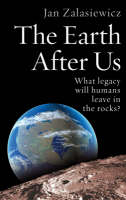
The Earth After Us
What Legacy Will Humans Leave in the Rocks?
Seiten
2008
Oxford University Press (Verlag)
978-0-19-921497-6 (ISBN)
Oxford University Press (Verlag)
978-0-19-921497-6 (ISBN)
- Titel ist leider vergriffen;
keine Neuauflage - Artikel merken
If aliens came to Earth 100 millions years in the future, what traces would they find of long-extinct humanity's brief reign on the planet? This engaging and thought-provoking account looks at what our species will leave behind, buried deep in the rock strata, and provides us with a warning of our devastating environmental impact.
Geologist Jan Zalasiewicz takes the reader one hundred million years into the future, long after the human race became extinct, to explore what will remain of humanity's brief but dramatic sojourn on planet Earth. He tells how geologists in the far future - perhaps an alien species re-discovering Earth - might piece together the history of the planet, and slowly decipher the fact of humanity's existence, activities, and ultimate extinction from the traces we will leave impressed in the rock strata. The Earth After Us takes this novel approach to show how geologists unravel the information in the rocks. As the alien scientists start investigating the strata, what story will they tell of us? What kind of fossils will humans leave behind? What will happen to cities, cars, and plastic cups? How thick a layer will the 'human stratum' be? And will it be obvious which species dominated the planet? It reveals a story of an environmental crisis similar in scale to even earlier mass extinction events, yet puzzlingly different: a crisis where extinctions were accompanied by a bizarre global merry-go-round of organisms and by sharp perturbations of climate.The trail leads finally to the bones of the inhabitants of petrified cities that have lain deep underground for many millions of years.
As thought-provoking as it is engaging, this book simultaneously explains both the geological mechanisms that shape our planet, and also offers a perspective on humanity and its actions that may prove to be more objective than any other. For our final legacy, Zalasiewicz argues, will provide the ultimate verdict on our species and on our relationship to planet Earth.
Geologist Jan Zalasiewicz takes the reader one hundred million years into the future, long after the human race became extinct, to explore what will remain of humanity's brief but dramatic sojourn on planet Earth. He tells how geologists in the far future - perhaps an alien species re-discovering Earth - might piece together the history of the planet, and slowly decipher the fact of humanity's existence, activities, and ultimate extinction from the traces we will leave impressed in the rock strata. The Earth After Us takes this novel approach to show how geologists unravel the information in the rocks. As the alien scientists start investigating the strata, what story will they tell of us? What kind of fossils will humans leave behind? What will happen to cities, cars, and plastic cups? How thick a layer will the 'human stratum' be? And will it be obvious which species dominated the planet? It reveals a story of an environmental crisis similar in scale to even earlier mass extinction events, yet puzzlingly different: a crisis where extinctions were accompanied by a bizarre global merry-go-round of organisms and by sharp perturbations of climate.The trail leads finally to the bones of the inhabitants of petrified cities that have lain deep underground for many millions of years.
As thought-provoking as it is engaging, this book simultaneously explains both the geological mechanisms that shape our planet, and also offers a perspective on humanity and its actions that may prove to be more objective than any other. For our final legacy, Zalasiewicz argues, will provide the ultimate verdict on our species and on our relationship to planet Earth.
Jan Zalasiewicz is a Lecturer in Geology at the University of Leicester, before that working at the British Geological Survey. A field geologist, palaeontologist and stratigrapher, he teaches various aspects of geology and Earth history to undergraduate and postgraduate students, and is a researcher into fossil ecosystems and environments across over half a billion years of geological time. He has published over a hundred papers in scientific journals.
Prologue; 1. Perspective; 2. 100 Million Years AD; 3. The Strata Machine; 4. Tectonic Escalator; 5. High Water, Low Water; 6. Dynasties; 7. Echoes; 8. Traces; 9. Body of Evidence; 10. Meeting the People
| Erscheint lt. Verlag | 25.9.2008 |
|---|---|
| Zusatzinfo | 10 halftones and line drawings |
| Verlagsort | Oxford |
| Sprache | englisch |
| Maße | 138 x 216 mm |
| Gewicht | 468 g |
| Themenwelt | Sachbuch/Ratgeber ► Natur / Technik |
| Naturwissenschaften ► Geowissenschaften ► Geologie | |
| ISBN-10 | 0-19-921497-2 / 0199214972 |
| ISBN-13 | 978-0-19-921497-6 / 9780199214976 |
| Zustand | Neuware |
| Haben Sie eine Frage zum Produkt? |
Mehr entdecken
aus dem Bereich
aus dem Bereich


